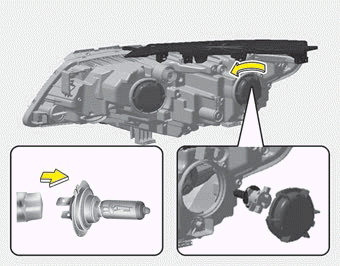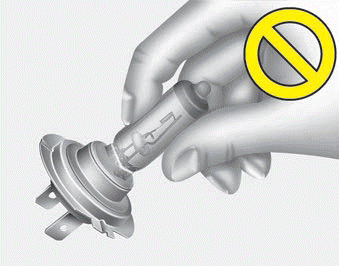Kia Optima: Light bulbs / Headlamp (Low beam) bulb replacement
Kia Optima DL3 2019-2025 Owner's Manual / Maintenance / Light bulbs / Headlamp (Low beam) bulb replacement

1. Open the hood.
2. Remove the headlamp bulb cover by turning it counterclockwise.
3. Remove the bulb-socket from the headlamp assembly by turning the bulb-socket counterclockwise until the tabs on the bulb-socket align with the slots on the headlamp assembly.
4. Remove the bulb from bulb-socket by pulling it out.
5. Insert a new bulb into the bulbsocket.
6. Install the bulb-socket in the headlamp assembly by aligning the tabs on the bulb-socket with the slots in the headlamp assembly. Push the bulb-socket into the headlamp assembly and turn the bulb-socket clockwise.
7. Install the headlamp bulb cover by turning it clockwise.
Headlamp bulb

WARNING - Halogen bulbs
Handle halogen bulbs with care.
- Halogen bulbs contain pressurized gas that will produce flying pieces of glass if broken.
- Always handle them carefully, and avoid scratches and abrasions. If the bulbs are lit, avoid contact with liquids. Never touch the glass with bare hands. Residual oil may cause the bulb to overheat and burst when lit. A bulb should be operated only when installed in a headlamp.
- If a bulb becomes damaged or cracked, replace it immediately and carefully dispose of it.
- Wear eye protection when changing a bulb. Allow the bulb to cool down before handling it.
 Light bulb position (Rear, Side)
Light bulb position (Rear, Side)
Light bulb position (Rear)
■ Rear combination lamp - Type A
■ Rear combination lamp - Type B
■ Rear combination lamp - Type C
■ License plate lamp
■ High mounted stop lamp
(1 ...
 Headlamp (High beam) bulb replacement
Headlamp (High beam) bulb replacement
1. Open the hood.
2. Remove the headlamp bulb cover by turning it counterclockwise.
3. Disconnect the headlamp bulb socket-connector.
4. Remove the bulb-socket from the headlamp assembly by turni ...
Other information:
Kia Optima DL3 2019-2025 Owner's Manual: Check tire pressure
You can check the tire pressure in the information mode on the cluster. - Refer to “User settings mode” in chapter 4. Tire pressure is displayed 1~2 minutes later after driving. If tire pressure is not displayed when the vehicle is stopped, “Drive to display” message displays. ...
Kia Optima DL3 2019-2025 Service and Repair Manual: Surround View Monitor (SVM) Camera
Schematic diagrams Connector and Terminal function Front View Camera Side View Camera Rear View Camera Repair procedures Removal In case of bad quality or poor focus, be sure to check the ...
Copyright © www.kioptima.com 2017-2025

